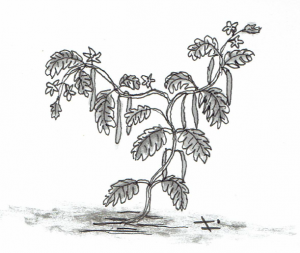Difference between revisions of "Bite Bean"
From World of Entorais Wiki
Jump to navigationJump to searchm (picture tags) |
(layout) |
||
| Line 1: | Line 1: | ||
[[File:Bite_bean.png|thumb|right|200x|''Bite Bean'' - Sebastian Romu © 2018]] | [[File:Bite_bean.png|thumb|right|200x|''Bite Bean'' - Sebastian Romu © 2018]] | ||
=Description= | |||
;Common Names:Bite Bean | ;Common Names:Bite Bean | ||
;Classification:Herbaceous, Vine, Legume | ;Classification:Herbaceous, Vine, Legume | ||
This flowering vine boasts pleasant pink five-petalled flowers and broad toothed leaves. The oil which can be pressed from the seeds is often used to makes a salve for insect stings and bites. The beans can also be dry-roasted and ground to make a brewed tonic. | :This flowering vine boasts pleasant pink five-petalled flowers and broad toothed leaves. The oil which can be pressed from the seeds is often used to makes a salve for insect stings and bites. The beans can also be dry-roasted and ground to make a brewed tonic. | ||
=Ecology= | |||
;Rarity:bite Bean is a common plant in all but the driest regions. | ;Rarity:bite Bean is a common plant in all but the driest regions. | ||
;Distribution: Typically found on borders and margins of woodlands. | ;Distribution: Typically found on borders and margins of woodlands. | ||
;Life Cycle:Annual | ;Life Cycle:Annual | ||
=Uses= | |||
;Cultivation:wild | ;Cultivation:wild | ||
;Culinary:Bite bean sees no use as a domestic legume due to having a bitter oily taste and low yield of bean pods per plant. | ;Culinary:Bite bean sees no use as a domestic legume due to having a bitter oily taste and low yield of bean pods per plant. | ||
;Medicinal:tonic (seeds), vulnerary salve (seed oil) | ;Medicinal:tonic (seeds), vulnerary salve (seed oil) | ||
;Other:<!-- other uses--> | ;Other:<!-- other uses--> | ||
The oil which can be pressed from the seeds is often used to makes a salve for insect stings and bites. The beans can also be dry-roasted and ground to make a brewed tonic. | :The oil which can be pressed from the seeds is often used to makes a salve for insect stings and bites. The beans can also be dry-roasted and ground to make a brewed tonic. | ||
=Culture= | |||
<!-- unique cultural notes--> | <!-- unique cultural notes--> | ||
==See Also | =Stories= | ||
=See Also= | |||
[[Category:Flora]] | [[Category:Flora]] | ||
Revision as of 19:31, 25 December 2019
Description
- Common Names
- Bite Bean
- Classification
- Herbaceous, Vine, Legume
- This flowering vine boasts pleasant pink five-petalled flowers and broad toothed leaves. The oil which can be pressed from the seeds is often used to makes a salve for insect stings and bites. The beans can also be dry-roasted and ground to make a brewed tonic.
Ecology
- Rarity
- bite Bean is a common plant in all but the driest regions.
- Distribution
- Typically found on borders and margins of woodlands.
- Life Cycle
- Annual
Uses
- Cultivation
- wild
- Culinary
- Bite bean sees no use as a domestic legume due to having a bitter oily taste and low yield of bean pods per plant.
- Medicinal
- tonic (seeds), vulnerary salve (seed oil)
- Other
- The oil which can be pressed from the seeds is often used to makes a salve for insect stings and bites. The beans can also be dry-roasted and ground to make a brewed tonic.
